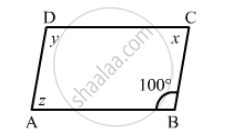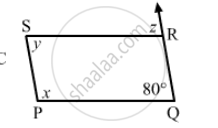Advertisements
Advertisements
Question
The following figure is parallelogram. Find the degree values of the unknowns x, y, z.

Solution
\[\text{ Opposite angles of a parallelogram are same } . \]
\[ \therefore x = z \text{ and } y = 100°\]
\[\text{ Also }, y + z = 180° (\text{ sum of adjacent angles of a quadrilateral is } 180°)\]
\[z + 100°= 180°\]
\[x = 180° - 100°\]
\[x = 80°\]
\[ \therefore x = 80°e, y = 100° \text{ and } z = 80°\]
APPEARS IN
RELATED QUESTIONS
The following figure is parallelogram. Find the degree values of the unknown x, y, z.

The perimeter of a parallelogram is 150 cm. One of its sides is greater than the other by 25 cm. Find the length of the sides of the parallelogram.
Which of the following statement is true for a rhombus?
It can be a square.
The diagonals of a parallelogram are not perpendicular. Is it a rhombus? Why or why not?
Draw a rhombus, having each side of length 3.5 cm and one of the angles as 40°.
ABCD is a rhombus and its diagonals intersect at O.
(i) Is ∆BOC ≅ ∆DOC? State the congruence condition used?
(ii) Also state, if ∠BCO = ∠DCO.
Lengths of diagonals of a rhombus ABCD are 16 cm and 12 cm. Find the side and perimeter of the rhombus.
In rhombus ABCD;
(i) if ∠A = 74° ; find ∠B and ∠C.
(ii) if AD = 7.5 cm ; find BC and CD.
A quadrilateral whose all sides are equal, opposite angles are equal and the diagonals bisect each other at right angles is a ______.
If the adjacent sides of a parallelogram are equal then parallelogram is a ______.
